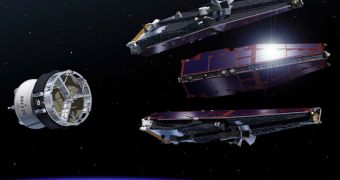Officials with the European Space Agency (ESA) say that the new Swarm constellation of satellites is in good health in Earth's orbit, and has already started supplying invaluable readings of our planet's magnetic field. The constellation consists of three identical spacecraft.
The mission was launched on November 22, aboard a Rockot delivery system, from the Plesetsk Cosmodrome, in Russia. The spacecraft trio was inserted in a geocentric polar orbit at an altitude of about 460 kilometers (290 miles), slightly higher than the International Space Station.
The spacecraft began transmitting data from their instruments on November 26, after four days of tests and calibrations. Each Swarm carried with it a vector field magnetometer (VFM), an absolute scalar magnetometer (ASM), an electric field instrument (EFI), an accelerometer (ACC) and a laser range reflector (LRR).
With these sensitive tools aboard, the satellites will be able to survey the direction and strength of Earth's magnetic field in more detail than ever before. ESA experts hope the mission will shed more light on the planet's ionosphere, magnetosphere, molten iron core, and other areas, IEEE Spectrum reports.
Overall, a Swarm satellite looks like a horseshoe crab. Its carapace is covered in solar cells, while its tail looks like a rapier. The tail unfolded once the spacecraft reached space, and is now around 4.3 meters (14 feet) long. It is made up of a polymer material, reinforced with carbon fibers.
This component of the spacecraft does not feature any magnetic parts because it represents the area where all the sensitive scientific instruments are installed. VEM, for example, is located halfway down the boom. This is the main instrument around which the entire mission is built.
The ASM is located at the end of the polymer boom. It is constructed by Grenoble. France-based CEA-Leti, with additional support from the French national space agency (CNES) and the Institut de Physique du Globe de Paris. The purpose of this instrument is to keep the VFM calibrated at all times.
The Swarm constellation is managed by engineers from the ESA European Space Operations Center (ESOC), in Germany. Since November 22, mission controllers here have conducted a variety of tests, checks and configurations on the three satellites, including power, altitude, thermal and orientation verifications.
All systems were put through their paces, and came through with flying colors. Swarm is now collecting date on Earth's magnetic field at a resolution impossible just a few years ago.

 14 DAY TRIAL //
14 DAY TRIAL //